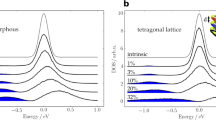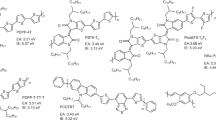Abstract
Conjugated polymers such as poly(p-phenylene vinylene)s (PPVs) allow low-cost fabrication of thin semiconducting films by solution processing onto substrates. Several polymeric optoelectronic devices have been developed in recent years, including field-effect transistors1, light-emitting diodes2, photocells3,4 and lasers5. It is still not clear, however, whether the description of electronic excitations in these materials is most appropriately formulated within a molecular or semiconductor (band-theory) picture. In the former case, excited states are localized and are described as excitons; in the latter they are delocalized and described as free electron–hole pairs. Here we report studies of the electronic states associated with optical excitations in the visible and ultraviolet range for the conjugated polymer poly(2-methoxy-5-(2′-ethyl-hexyloxy)-p-phenylene vinylene) (MEH-PPV), by means of photocurrent measurements and quantum-chemical calculations. We find several photocurrent spectral features between 3 and 5 eV which are coupled with bands in the absorption spectrum. On modelling the excited states in this energy range, we have discovered an important feature that is likely to be general for materials composed of coupled molecular units: that mixing of delocalized conduction- and valence-band states with states localized on the molecular units produces a sequence of excited states in which positive and negative charges can be separated further at higher energies. In other words, these excited states facilitate charge separation, and provide a conceptual bridge between the molecular (localized) and semiconductor (delocalized) pictures.
This is a preview of subscription content, access via your institution
Access options
Subscribe to this journal
Receive 51 print issues and online access
$199.00 per year
only $3.90 per issue
Buy this article
- Purchase on Springer Link
- Instant access to full article PDF
Prices may be subject to local taxes which are calculated during checkout




Similar content being viewed by others
References
Garnier, F., Hajlaoui, R., Yassar, A. & Srivastava, P. All-polymer field-effect transistor realized by printing techniques. Science 265, 1684–1686 (1994).
Burroughes, J. H. et al. Light-emitting diodes based on conjugated polymers. Nature 347, 539–541 (1990).
Halls, J. J. M. et al. Efficient photodiodes from interpenetrating polymer networks. Nature 376, 498–500 (1995).
Yu, G., Gao, J., Hummelen, J. C., Wudl, F. & Heeger, A. J. Polymer photovoltaic cells: Enhanced efficiencies via a network of internal donor–acceptor heterojunctions. Science 270, 1789–1791 (1995).
Tessler, N., Denton, G. J. & Friend, R. H. Lasing from conjugated-polymer microcavities. Nature 382, 695–697 (1996).
Lee, C. H., Yu, G., Moses, D. & Heeger, A. J. Picosecond transient photoconductivity in poly(p-phenylenevinylene). Phys. Rev. B 49, 2396–2407 (1994).
Heun, S. et al. Conformational effects in poly(p-phenylene vinylene) revealed by low-temperature site-selective fluorescence. J. Phys.: Condens. Matter 5, 247–260 (1993).
Rauscher, U., Bässler, H., Bradley, D. D. C. & Hennecke, M. Exciton versus band description of the absorption and luminescence spectra in poly(para-phenylenevinylene). Phys. Rev. B 42, 9830–9836 (1990).
Brédas, J. L., Cornil, J. & Heeger, A. J. The exciton binding energy in luminescent conjugated polymers. Adv. Mater. 8, 447–452 (1996).
Fromherz, P. & Rieger, B. Photoinduced electron transfer in DNA matrix from intercalated ethidium to condensed methylviologen. J. Am. Chem. Soc. 108, 5361–5362 (1986).
Hall, D. B., Holmlin, R. E. & Barton, J. K. Oxidative DNA damage through long-range electron transfer. Nature 382, 731–735 (1996).
Pichler, K. et al. Optical spectroscopy of highly ordered poly(p-phenylene vinylene). J. Phys.: Condens. Matter. 5, 7155–7172 (1993).
Chandross, M. et al. Excitons in poly(para-phenylenevinylene). Phys. Rev. B 50, 14702–14705 (1994).
Tang, C. W. & Albrecht, A. C. Photovoltaic effects of metal-chlorophyll-metal sandwich cells. J. Chem. Phys. 62, 2139–2149 (1974).
Marks, R. N., Halls, J. J. M., Bradley, D. D. C., Friend, R. H. & Holmes, A. B. The photovoltaic response in poly(p-phenylene vinylene) thin-film devices. J. Phys.: Condens. Matter 6, 1379–1394 (1994).
Harrison, M. G., Grüner, J. & Spencer, G. C. W. Analysis of the photocurrent action spectra of MEH-PPV polymer photodiodes. Phys. Rev. B 55, 7831–7849 (1997).
Kraus, A., Gügel, A., Belik, P., Walter, M. & Müllen, K. Covalent attachment of various substituents in closest proximity ot the C60-core: A broad synthetic approach to stable fullerene derivatives. Tetrahedron 51, 9927–9940 (1996).
Cornil, J., Beljonne, D., Friend, R. H. & Brédas, J. L. Optical absorptions in poly(para-phenylene vinylene) and poly(2.5-dimethoxy-1,4-para-phenylene vinylene) oligomers. Chem. Phys. Lett. 223, 82–88 (1994).
Gartstein, Y. N., Rice, M. J. & Conwell, E. M. Electron–hole interaction effects in the absorption-spectra of phenylene-based conjugated polymers. Phys. Rev. B 52, 1683–1691 (1995).
Chandross, M. et al. Optical absorption in the substituted phenylene-based conjugated polymers: Theory and experiment. Phys. Rev. B 55, 1486–1496 (1997).
Kersting, R. et al. Femtosecond energy relaxation in π-conjugated polymers. Phys. Rev. Lett. 70, 3820–3823 (1993).
Hayes, G. H., Samuel, I. D. W. & Phillips, R. T. Exciton dynamics in electroluminescent polymers studied by femtosecond time-resolved photoluminescence spectroscopy. Phys. Rev. B 52, R11569–R11572 (1995).
Harrison, N. T., Hayes, G. R., Phillips, R. T. & Friend, R. H. Singlet intrachain exciton generation and decay in poly(p-phenylenevinylene). Phys. Rev. Lett. 77, 1881–1884 (1996).
Rothberg, L. J. et al. Intrinsic and extrinsic constrains on phenylenevinylene polymer electroluminescence. Synth. Met. 78, 231–236 (1996).
Barth, S., Bässler, H., Rost, H. & Hörhold, H. H. Extrinsic and intrinsic dc photoconductivity in a conjugated polymer. Phys. Rev. B 56, 3844–3851 (1997).
Pope, M. & Swenberg, C. E. Electron Processes in Organic Crystals (Clarendon, Oxford, 1982).
Gutmann, F. & Lyons, L. E. Organic Semiconductors (Wiley, New York, 1967).
Salaneck, W. R., Stafström, S. & Brédas, J.-L. Conjugated Polymer Surfaces and Interfaces (Cambridge Univ. Press, 1996).
Acknowledgements
We thank M. Harrison, S. Graham, P. Hamer and S. C. Moratti for discussions, and J.J. M. Halls for assistance with the UV photovoltaics equipment and for discussions. One of us (A.K.) thanks Wolfson College and Peterhouse in Cambridge for financial support. The Cambridge–Mons collaboration is supported by the European Commission (TMR Network ‘SELOA’ and ESPRIT project ‘LEDFOS’). Work in Mons is partly supported by the Belgian Prime Minister Services for Scientific, Technical, and Cultural Affairs (IAP in Supramolecular Chemistry and Catalysis), FNRS-FRFC, and an IBM Academic Joint Study. D.B. is Chargé de Recherches FNRS.
Author information
Authors and Affiliations
Corresponding author
Rights and permissions
About this article
Cite this article
Köhler, A., dos Santos, D., Beljonne, D. et al. Charge separation in localized and delocalized electronic states in polymeric semiconductors. Nature 392, 903–906 (1998). https://doi.org/10.1038/31901
Received:
Accepted:
Issue Date:
DOI: https://doi.org/10.1038/31901
This article is cited by
-
Sub-10-fs observation of bound exciton formation in organic optoelectronic devices
Nature Communications (2022)
-
Orientation dependent molecular electrostatics drives efficient charge generation in homojunction organic solar cells
Nature Communications (2020)
-
DFT/TD-DFT study on halogen doping and solvent contributions to the structural and optoelectronic properties of poly[3,6-carbazole] and poly[indolo(3,2-b)-carbazole]
Structural Chemistry (2018)
-
Synthesis, Spectral, Electrochemical and Theoretical Investigation of indolo[2,3-b]quinoxaline dyes derived from Anthraquinone for n–type materials
Journal of Chemical Sciences (2017)
-
Photogenerated Intrinsic Free Carriers in Small-molecule Organic Semiconductors Visualized by Ultrafast Spectroscopy
Scientific Reports (2015)
Comments
By submitting a comment you agree to abide by our Terms and Community Guidelines. If you find something abusive or that does not comply with our terms or guidelines please flag it as inappropriate.



